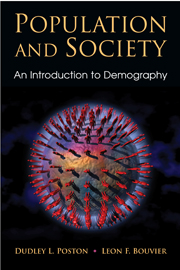Book contents
- Frontmatter
- Contents
- Preface
- Introduction
- 1 “We Are All Population Actors”: An Introduction to Demography
- 2 The Sources of Demographic Information
- 3 Fertility
- 4 Contraception and Birth Control
- 5 Mortality
- 6 Internal Migration
- 7 International Migration
- 8 Age and Sex Composition
- 9 World Population Change over Time
- 10 Population Change in the United States
- 11 Population Distribution
- 12 Cultural Adaptation and Growth
- 13 Population Policy
- 14 The Future of Planet Earth
- Glossary
- References
- Author Index
- Subject Index
1 - “We Are All Population Actors”: An Introduction to Demography
- Frontmatter
- Contents
- Preface
- Introduction
- 1 “We Are All Population Actors”: An Introduction to Demography
- 2 The Sources of Demographic Information
- 3 Fertility
- 4 Contraception and Birth Control
- 5 Mortality
- 6 Internal Migration
- 7 International Migration
- 8 Age and Sex Composition
- 9 World Population Change over Time
- 10 Population Change in the United States
- 11 Population Distribution
- 12 Cultural Adaptation and Growth
- 13 Population Policy
- 14 The Future of Planet Earth
- Glossary
- References
- Author Index
- Subject Index
Summary
INTRODUCTION
This book introduces you to the study of demography. What is demography? It is the systematic and scientific study of human populations. The word demography comes from the Greek words δημοσ (demos) for population and γραϕια (graphia) for “description” or “writing,” thus the phrase, “writings about populations.” The term demography is believed to have first been used in 1855 by the Belgian statistician Achille Guillard in his book Elements of Human Statistics or Comparative Demography (Borrie, 1973: 75; Rowland, 2003: 16). There is fair agreement among demographers (Hauser and Duncan, 1959; McFalls, 2003; Micklin and Poston, 2005; Pressat, 1985; Rowland, 2003) about the objectives and definition of demography.
Demography is the social science that studies 1) the size, composition, and distribution of the human population of a given area at a specific point in time; 2) changes in population size and composition; 3) the components of these changes (fertility, mortality, and migration); 4) the factors that affect these components; and 5) the consequences of changes in population size, composition, and distribution, or in the components themselves. Demography may be defined as the scientific study of the size, composition, and distribution of human populations and their changes resulting from fertility, mortality, and migration. Demography is concerned with how large (or small) populations are; how populations are composed according to age, sex, race, marital status, and other characteristics; and how populations are distributed in physical space (e.g., how urban and rural they are) (Bogue, 1969).
- Type
- Chapter
- Information
- Population and SocietyAn Introduction to Demography, pp. 3 - 14Publisher: Cambridge University PressPrint publication year: 2010

